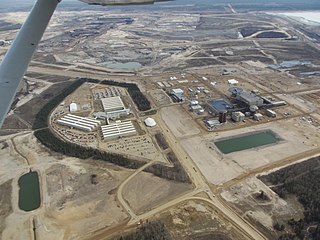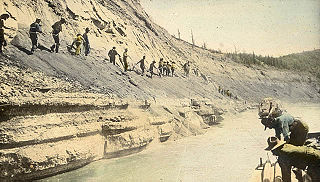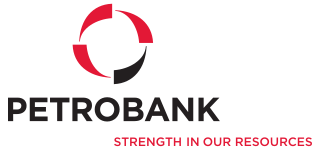
Oil sands, tar sands, crude bitumen, or bituminous sands, are a type of unconventional petroleum deposit. Oil sands are either loose sands or partially consolidated sandstone containing a naturally occurring mixture of sand, clay, and water, soaked with bitumen, a dense and extremely viscous form of petroleum.

The Athabasca oil sands, also known as the Athabasca tar sands, are large deposits of bitumen or extremely heavy crude oil, located in northeastern Alberta, Canada – roughly centred on the boomtown of Fort McMurray. These oil sands, hosted primarily in the McMurray Formation, consist of a mixture of crude bitumen, silica sand, clay minerals, and water. The Athabasca deposit is the largest known reservoir of crude bitumen in the world and the largest of three major oil sands deposits in Alberta, along with the nearby Peace River and Cold Lake deposits.
Steam-assisted gravity drainage is an enhanced oil recovery technology for producing heavy crude oil and bitumen. It is an advanced form of steam stimulation in which a pair of horizontal wells is drilled into the oil reservoir, one a few metres above the other. High pressure steam is continuously injected into the upper wellbore to heat the oil and reduce its viscosity, causing the heated oil to drain into the lower wellbore, where it is pumped out. Dr. Roger Butler, engineer at Imperial Oil from 1955 to 1982, invented the steam assisted gravity drainage (SAGD) process in the 1970s. Butler "developed the concept of using horizontal pairs of wells and injected steam to develop certain deposits of bitumen considered too deep for mining". In 1983 Butler became director of technical programs for the Alberta Oil Sands Technology and Research Authority (AOSTRA), a crown corporation created by Alberta Premier Lougheed to promote new technologies for oil sands and heavy crude oil production. AOSTRA quickly supported SAGD as a promising innovation in oil sands extraction technology.
Connacher Oil and Gas Limited is a Calgary-based exploration, development and production company active in the production and sale of bitumen in the Athabasca oil sands region. Connacher's shares used to trade on the Toronto Stock Exchange, but it was de-listed in 2016, after filing for insolvency.

Canada's oil sands and heavy oil resources are among the world's great petroleum deposits. They include the vast oil sands of northern Alberta, and the heavy oil reservoirs that surround the small city of Lloydminster, which sits on the border between Alberta and Saskatchewan. The extent of these resources is well known, but better technologies to produce oil from them are still being developed.

The Kearl Oil Sands Project is an oil sands mine in the Athabasca Oil Sands region at the Kearl Lake area, about 70 kilometres (43 mi) north of Fort McMurray in Alberta, Canada. The project is being developed in three phases with the first phase completed mid-2013.

Steam injection is an increasingly common method of extracting heavy crude oil. It is considered an enhanced oil recovery (EOR) method and is the main type of thermal stimulation of oil reservoirs. There are several different forms of the technology, with the two main ones being Cyclic Steam Stimulation and Steam Flooding. Both are most commonly applied to oil reservoirs, which are relatively shallow and which contain crude oils which are very viscous at the temperature of the native underground formation. Steam injection is widely used in the San Joaquin Valley of California (US), the Lake Maracaibo area of Venezuela, and the oil sands of northern Alberta (Canada).

The Fort McKay First Nation (FMFN) is a First Nations government in northeast Alberta comprising five Indian reserves – Fort McKay 174, Fort McKay 174C, Fort McKay 174D, Namur Lake 174B and Namur River 174A. The FMFN, signed to Treaty 8, is affiliated with the Athabasca Tribal Council and its members are of Cree, Metis and Dene heritage. The FMFN's traditional lands include portions of the Athabasca oil sands.

Albian Sands Energy Inc. is the operator of the Muskeg River Mine and Jack Pine Mine, an oil sands mining project located 75 kilometres (47 mi) north of Fort McMurray, Alberta, Canada. It is a joint venture between Shell Canada (10%), CNRL (70%) and Chevron Canada (20%). The company's legal headquarters are located in the Shell Tower in Calgary, Alberta. Albian Sands got its name from the Albian Boreal Sea which, during the Albian stage of the Cretaceous, moved over the McMurray sands and deposited a blanket of marine shale on its floor which trapped the hydrocarbons of the McMurray Formation. The oil sands resources of the Muskeg River Mine are a legacy of the Albian Sea.
Japan Canada Oil Sands Limited (JACOS) was an oil sands extraction company. It was the operator of the Hangingstone oil sands project. JACOS was acquired by Greenfire Resources Operating Corporation in 2021.
The Alberta Oil Sands Technology and Research Authority (AOSTRA) was an Alberta crown corporation to promote the development and use of new technology for oil sands and heavy crude oil production, and enhanced recovery of conventional crude oil. It was funded by the Alberta Heritage Savings Trust Fund. Its head office and information centre were located in Edmonton, Alberta and a second office in Calgary, Alberta in Canada.
The Clearwater Formation is a stratigraphic unit of Early Cretaceous (Albian) age in the Western Canada Sedimentary Basin in northeastern Alberta, Canada. It was first defined by R.G. McConnell in 1893 and takes its name from the Clearwater River near Fort McMurray.

The McMurray Formation is a stratigraphic unit of Early Cretaceous age of the Western Canada Sedimentary Basin in northeastern Alberta. It takes the name from Fort McMurray and was first described from outcrops along the banks of the Athabasca River 5 kilometres (3.1 mi) north of Fort McMurray by F.H. McLearn in 1917. It is a well-studied example of fluvial to estuarine sedimentation, and it is economically important because it hosts most of the vast bitumen resources of the Athabasca Oil Sands region.
Cenovus Energy Inc. is an integrated oil and natural gas company headquartered in Calgary, Alberta.

Petrobank was an oil exploration, development, and production company based in Calgary, Canada. It operates through 4 units/subsidiaries, PetroBakken Energy in Canada, Petrominerales Ltd in Peru and Colombia, HBU in the heavy crude oil business, and its technology unit Archon Technologies Ltd . In 1986 the company changed its name from Petrobank Energy Resources Ltd. to Petrobank Energy and Resources Ltd. Though it has a significant resource base its ten patents for heavy oil extracting technology are becoming increasingly valuable to the company. In December 2010 the company received permission from the government of Alberta to produce oil sands bitumen at a new location in Dawson using a technique known as fireflooding, the third Petrobank operation that will use it; the 50% interest in Dawson was acquired in October from Shell Canada.

The Long Lake oil sands upgrader project is an in situ oil extraction project near Anzac, Alberta, 40 km (25 mi) southeast of Fort McMurray in the Athabasca oil sands region of Alberta.
MEG Energy is a pure play Canadian oil sands producer engaged in exploration in Northern Alberta. All of its oil reserves are more than 1,000 feet (300 m) below the surface and so they depend on steam-assisted gravity drainage and associated technology to produce. The company's main thermal project is Christina Lake. 85-megawatt cogeneration plants are used to produce the steam used in SAGD which is required to bring bitumen to the surface. The excess heat and electricity produced at its plants is then sold to Alberta's power grid. Its proven reserves have been independently pegged at 1.7 billion barrels and probable reserves 3.7 billion barrels ; That's significant considering only 300 billion barrels of the 1.6 trillion barrels of bitumen in Alberta is considered recoverable under current technology. The value of those reserves is over $19.8 billion. CNOOC has a minority 16.69% interest in MEG Energy.
The Grosmont Formation is a stratigraphical unit of Frasnian age in the Western Canadian Sedimentary Basin.

Located in northwest-central Alberta, the Peace River oil sands deposit is the smallest of four large deposits of oil sands of the Western Canadian Sedimentary Basin formation.

Horizon Oil Sands is an oil sands mining and upgrading project in Bitumount, Alberta, Canada. The project includes a surface oil sands mining and bitumen extraction plant, complemented by on-site bitumen upgrading with associated infrastructure.












